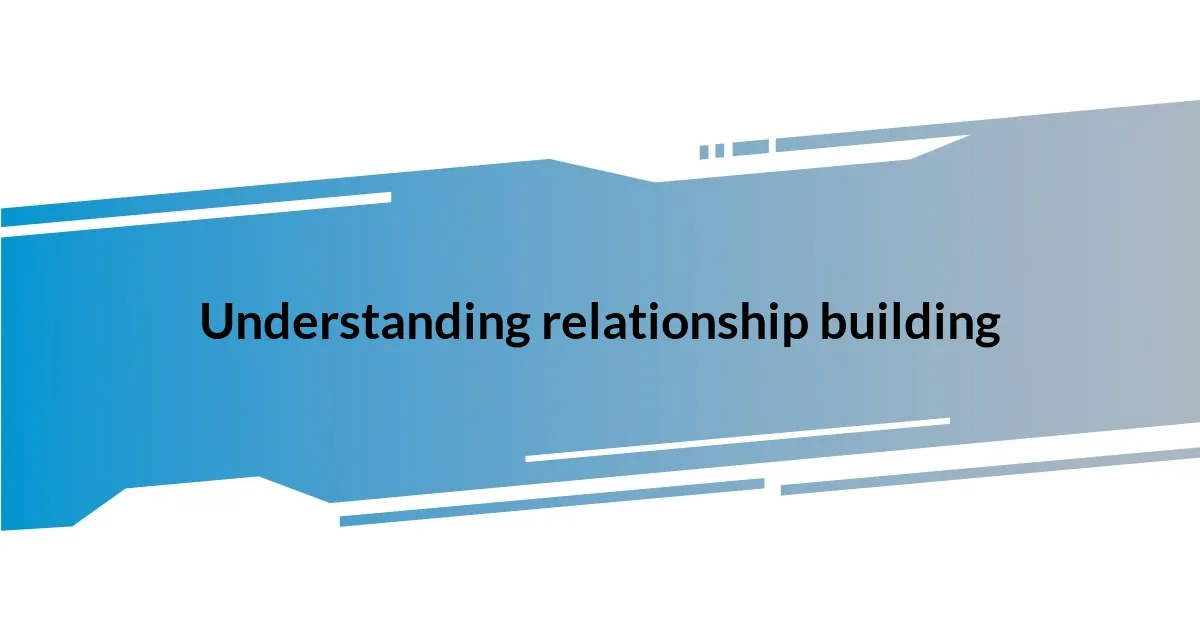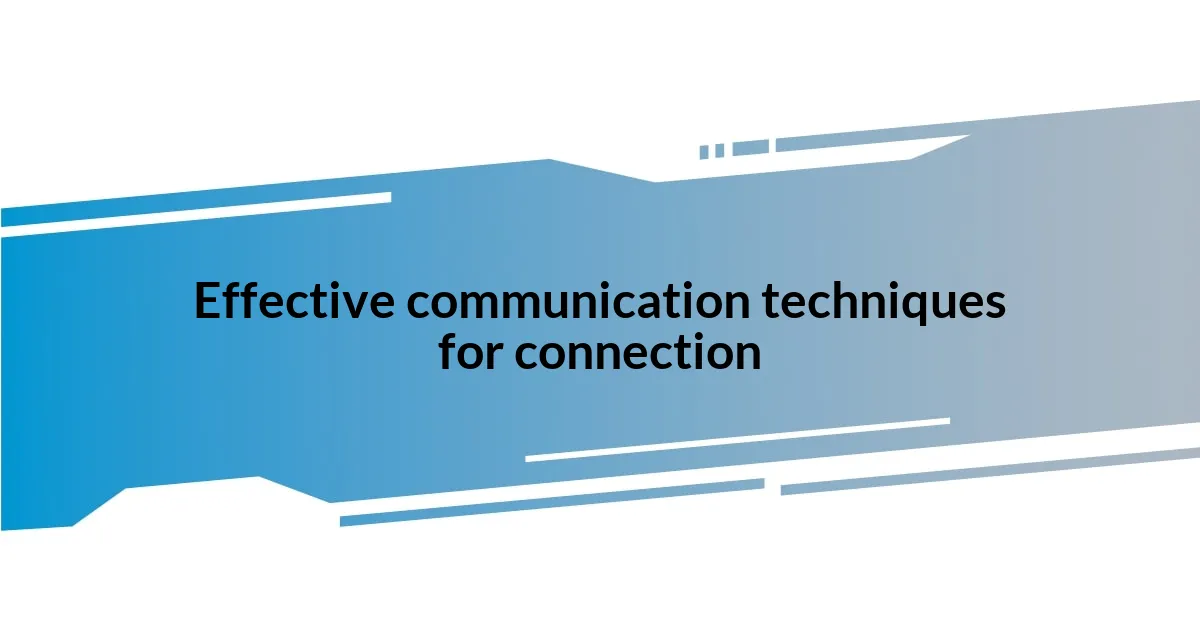Key takeaways:
- Building genuine connections involves meaningful conversations, empathy, and active listening, which foster trust and deeper relationships.
- Clearly identifying your connection goals enhances interactions and allows for more purposeful engagement, whether seeking mentorship, networking, or friendships.
- Maintaining connections through timely and personalized follow-ups demonstrates care and keeps relationships thriving, while leveraging social networks can amplify growth opportunities.

Understanding relationship building
Building connections is more than just exchanging pleasantries; it’s about genuinely investing in people. I remember a time when I attended a networking event, overwhelmed by the crowd. Instead of just trying to meet as many people as possible, I focused on having meaningful conversations. It was during a chat about shared interests that I found a friend who later became a collaborator.
Have you ever felt that spark when discussing something you’re passionate about? That’s the magic of relationship building. It’s those authentic moments that foster trust and create a foundation for deeper connections. I often find that sharing personal stories allows the other person to open up, making the bond feel more human and less transactional.
In navigating relationships, empathy plays a crucial role. I’ve noticed that when I actively listen and validate others’ feelings, it not only strengthens our connection but also encourages a safer space for honest dialogue. Isn’t it fascinating how just being present can transform a typical interaction into a memorable experience? This is the heart of relationship building—finding common ground and nurturing those connections over time.

Identifying your connection goals
Identifying what you hope to achieve from your connections is crucial. In my experience, setting clear goals not only steers the direction of the conversation but also helps in evaluating the quality of those interactions. For instance, when I attend professional gatherings, I often ask myself if I’m seeking mentorship, collaboration, or just new friendships. Knowing my primary goal allows me to engage in discussions that align with my intentions.
It can also be helpful to reflect on past experiences to identify successful and meaningful connections. I remember attending a workshop where I found myself drawn to a group project; my desire was to learn from others with different perspectives. This small shift in focus led to lasting friendships and valuable professional networks. When I look back, those moments shaped my understanding of what connection really means.
Being honest about your connection goals can sometimes feel daunting, but it’s a pivotal step. Think about it—do you want to expand your career, explore new hobbies, or simply enjoy new friendships? This self-awareness empowers you to choose interactions that resonate deeply, ensuring that every connection adds value to your life journey. Understanding your intentions not only enhances your relationship-building skills but also infuses your interactions with authenticity and purpose.
| Connection Goals | Examples |
|---|---|
| Mentorship | Aim to gain insights and guidance from experienced individuals in your field |
| Networking | Forge professional relationships that could lead to job opportunities or collaborations |
| Friendship | Connect with like-minded individuals for social support and camaraderie |

Practical strategies for active listening
Active listening isn’t just about hearing words; it’s about truly comprehending the essence of what someone is communicating. I recall a conversation with a colleague, where, instead of just waiting for my turn to speak, I made a conscious effort to pay attention to not only her words but also her emotions. What struck me was how that single shift made her feel valued—she opened up more than I expected, sharing insights that deepened our professional bond.
- Maintain eye contact to show you are fully engaged in the conversation.
- Use verbal nods like “I see” or “That’s interesting” to encourage the speaker to continue.
- Paraphrase or summarize what you’ve heard to confirm your understanding and demonstrate attentiveness.
- Ask open-ended questions that invite deeper exploration of their thoughts and feelings.
- Set aside distractions, like your phone, to create an environment conducive to focused listening.
Each of these strategies has become a tool in my toolkit for fostering genuine connections. The beauty of active listening lies in its simplicity yet profound impact. For instance, during a heartfelt discussion with a friend going through a tough time, I made it a point to listen without jumping in with solutions right away. Just being there, fully present, made a world of difference for both of us, giving her the space to express herself freely. It’s these moments of connection that often lead to deeper understanding and trust.

Effective communication techniques for connection
When it comes to effective communication, I find that being genuine resonates more than anything rehearsed. One technique that I cherish is sharing personal stories relevant to the conversation. I once shared a funny mishap I had while learning a new skill, and it instantly lightened the mood and made the other person feel comfortable enough to share their own experiences. It’s funny how vulnerability can turn a simple exchange into a meaningful interaction. Have you ever thought about how a little honesty can pave the way for deeper bonds?
Another powerful technique I’ve embraced is the art of asking thoughtful questions. I remember chatting with someone at a gathering who sparked my curiosity. Instead of sticking to surface-level topics, I asked what inspired their career choices. The conversation blossomed, revealing their passions and aspirations. By encouraging them to delve deeper, not only did I gain insights into their journey, but I also felt a stronger connection developing. Isn’t it remarkable how a simple question can unlock a treasure chest of stories?
Moreover, non-verbal cues are incredibly telling in communication. I learned this firsthand during a volunteering experience. As I interacted with a group of individuals from diverse backgrounds, I noticed how a warm smile or an open posture changed the dynamics. People became more relaxed and willing to engage. It made me realize—how often do we underestimate the power of our body language in fostering connection? By being aware of these subtle signals, we can truly enhance the quality of our interactions.

Maintaining connections through follow-up
Follow-up is where the magic of maintaining connections truly happens. I remember reaching out to a mentor after our initial meeting. It was a simple email, just sharing a takeaway from our discussion. That small gesture not only reiterated my appreciation for her insights but also kept the door open for further dialogue. It’s fascinating how a straightforward follow-up can reignite an interaction and demonstrate that you genuinely value the connection.
I’ve also found that timing plays a key role in effective follow-ups. After attending an engaging workshop, I made a point to connect with fellow attendees on social media. A couple of days later, I sent a message referencing a shared moment from the event. The response was overwhelmingly positive! It felt like we had instantly locked in on that experience, deepening our rapport. Don’t you agree that a timely follow-up can make someone feel remembered and important?
Moreover, I’ve realized that personalizing my follow-ups enhances the connection even more. When someone shares a passion or challenge with me, I try to reference it in future conversations. For instance, after confiding in a colleague about her project struggles, I later sent her a resource I stumbled upon that might help. The delight in her response confirmed what I believe: It’s not just about staying connected; it’s about showing you care in specific, meaningful ways. What better way to build connections than to show genuine interest through thoughtful follow-ups?

Leveraging social networks for growth
Leveraging social networks for growth can be a game changer in both personal and professional realms. I recall early on in my career, I joined an online group for my industry, hoping to find others who shared my interests. The first post I made was a simple question about navigating a specific challenge. The responses poured in, and it felt incredible to witness a community come together, sharing insights that I would have never encountered on my own. Have you ever found yourself surprised by the wealth of knowledge within an online network?
One thing I’ve learned is the importance of engaging authentically in these networks. I once participated in a discussion forum dedicated to my field and took an extra step by not only answering questions but also sharing my personal experiences related to those queries. It was amazing to see how many others connected with my story, and those interactions led to new relationships and opportunities. Isn’t it rewarding when being open transforms a digital exchange into something more significant?
Additionally, I’ve seen that consistency is vital when leveraging social networks. I made it a habit to check in regularly, offering support or updates on my own journey. One day, a member reached out to me, expressing that my posts inspired them. That simple message reminded me that my contributions might ripple out further than I realized. How often do we overlook the power of our consistent presence in a community?
